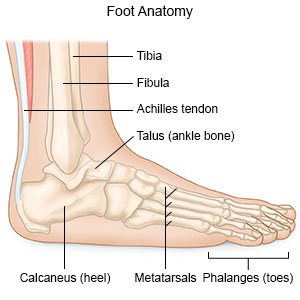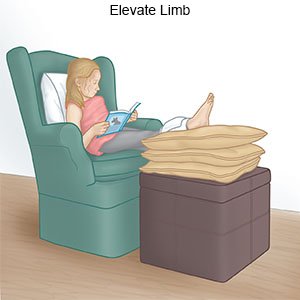Ankle Fracture in Children
Medically reviewed by Drugs.com. Last updated on Aug 4, 2025.
What is an ankle fracture in children?
An ankle fracture is a break in 1 or more of the bones in your child's ankle.
 |
What are the signs and symptoms of an ankle fracture in children?
- Pain, tenderness, and swelling
- Bruised or deformed ankle
- Trouble moving or putting weight on the ankle or foot
How is an ankle fracture in children diagnosed?
Your child's healthcare provider will ask about his or her injury and examine him or her. An x-ray, ultrasound, CT, or MRI may show a fracture, tissue damage, or other injuries. Your child may be given contrast liquid to help the fracture show up better in the pictures. Tell the healthcare provider if your child has ever had an allergic reaction to contrast liquid. Do not let your child enter the MRI room with anything metal. Metal can cause serious injury. Tell the healthcare provider if your child has any metal in or on his or her body.
How is an ankle fracture in children treated?
- Support devices , such as a brace, cast, or splint may be needed to limit your child's movement and protect his or her ankle. Do not remove your child's device. He or she may need to use crutches to decrease pain as he or she moves around. He or she should not put weight on the injured ankle.
- Pain medicine may be given. Ask your child's healthcare provider how to give this medicine safely.
- Closed reduction may be done to put your child's bones back into their correct position without surgery.
- Open reduction surgery is done when a closed reduction does not work or your child has ligament damage. An incision is made and the bones and ligaments are put back in the correct position. This may include the use of special wires, pins, plates or screws.
How can I manage my child's symptoms?
- Have your child rest his or her ankle so that it can heal.
- Apply ice on your child's ankle for 15 to 20 minutes every hour or as directed. Use an ice pack, or put crushed ice in a plastic bag. Cover it with a towel. Ice helps prevent tissue damage and decreases swelling and pain.
- Compress your child's ankle. Ask if you should wrap an elastic bandage around your child's ankle. An elastic bandage provides support and helps decrease swelling and movement so your child's ankle can heal. Have him or her wear the elastic bandage as directed.
- Elevate your child's ankle. Have your child elevate his or her ankle above the level of his or her heart as often as he or she can. This will help decrease swelling and pain. Prop his or her ankle on pillows or blankets to keep it elevated comfortably.

When should I seek immediate care?
- Blood soaks through your child's bandage.
- Your child has severe pain in his or her ankle.
- Your child's cast feels too tight.
- Your child's cast breaks or gets damaged.
- Your child's foot or toes feel cold or numb.
- Your child's foot or toenails turn blue or gray.
- Your child's swelling has increased or returned.
When should I call my child's doctor?
- Your child's splint feels too tight.
- Your child has a fever.
- You see new blood stains or notice a bad smell coming from under the cast or splint.
- Your child has more pain or swelling than he or she did before the cast or splint was put on.
- Your child's pain or swelling does not go away, even after treatment.
- You have questions or concerns about your child's condition or care.
Care Agreement
You have the right to help plan your child's care. Learn about your child's health condition and how it may be treated. Discuss treatment options with your child's healthcare providers to decide what care you want for your child. The above information is an educational aid only. It is not intended as medical advice for individual conditions or treatments. Talk to your doctor, nurse or pharmacist before following any medical regimen to see if it is safe and effective for you.© Copyright Merative 2025 Information is for End User's use only and may not be sold, redistributed or otherwise used for commercial purposes.
Learn more about Ankle Fracture
Treatment options
Care guides
Symptoms and treatments
Medicine.com guides (external)
Further information
Always consult your healthcare provider to ensure the information displayed on this page applies to your personal circumstances.
